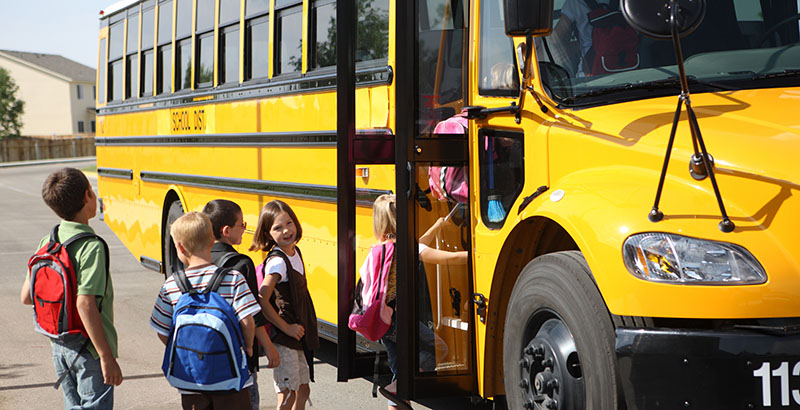A Parent’s Plea: My 8-Year-Old Wants to Ride the Big Yellow Bus With Her Friends, but Her School District Says That’s Impossible

This article originally appeared at BethHawkins.org
Meet Melissa Davis, the parent of a lovely young woman whose journey through special education in school I’ve been privileged to follow. And on whose shoulder I’ve cried a moment or two when my parallel trip has hit speed bumps.
Those of us who love and advocate for children with disabilities spend a lot of time comparing notes about the principle of inclusion, which means always, always, always erring on the side of making it possible for a student to participate in the same activities as their peers without disabilities.
This is rarely as expedient for the adults in charge of the system as “managing” our children via a separate process, so we spend a lot of time pushing for things that to others may seem inconsequential. We want our children to reach their full academic potential, and we also want them to have someone to joke around with at lunch, teachers who see their quirky behaviors as coping mechanisms and not defiance and a community that sees their strengths.
In addition to being a Minnesota warrior mother, Melissa is a graduate of Partners in Policymaking, a terrific program sponsored by the state that builds advocacy capacity among people with disabilities and their family members. As such, she’s got a terrific understanding of how special ed can fail to deliver on its promise to tailor each child’s experience to their unique needs. She has refused to accept lackluster compromises for her daughter.
Melissa’s current struggle involves her daughter’s desire to ride the regular bus to school with her friends instead of the special ed bus. The district has responded with nonsensical and arbitrary reasons why they can’t (won’t?) accommodate the girl. The tussle has been going on for months now.
This is an important request for two reasons:
One, federal civil rights law guarantees the girl the right to the least restrictive placement possible, which rephrased in regular-person language means that she is to be included with her neurotypical peers as often and as much as she’s able.
Two, which bus she takes is an important part of the girl’s identity. My own son loved the special ed bus because he has sensory issues and appreciated the quiet. Melissa’s daughter doesn’t feel that way. If we can understand that the bathroom a child uses, or the right to sit with the other kids at lunch, are foundational to their self-image, why can’t we figure it out with regard to the bus?
Anyhow, here are Melissa’s own words about her daughter:
My 8-year-old daughter Jayanna is my hero. I say this because at the age of 2, Jayanna was diagnosed with autism. At the time of her diagnosis Jayanna was non-verbal, struggled daily with sensory overload and the frustration of being unable to communicate. For the next six years, she fought tirelessly through therapies and interventions to now be in a general education classroom with special education services.
This brave little girl wakes up every single day and faces struggles that most will never understand. She never gives up and does it all with a smile on her face. As parents, we tend to have a bias toward our own child’s greatness, but I see Jayanna’s spirit as all the best qualities that are missing in today’s world. Her perseverance, empathy, and gentle spirit are all things that make her exceptional.
Since she started school in St. Paul at the age of 4, Jayanna has been celebrated as a positive member of her classroom and school community. Inclusion in the general education classroom hasn’t always been easy, but at those difficult times is when as a team we addressed issues with added support for Jayanna that would mean more one-on-one time with a paraprofessional or accommodations. Adding these extra supports not only allowed her to be in a classroom with her peers, but provided her the confidence needed to be successful academically.
Despite my daughter’s proven success in inclusive environments with supports, her general education busing was replaced with special ed busing once we moved to a new district. Even though she has ridden a general ed bus with the assistance of a bus aide since she was 4, she is being denied the ability to do so in her new school.
My sweet child who only five years ago could not verbalize her feelings tells me daily how much she wants to be with her peers. One would think that proven success, a child’s request, and a mandate called least restrictive environment would be enough. Well, sadly, it is not.
In the decades since society has moved away from institutionalizing and segregating people with disabilities, there has been a new focus on person-centered planning. The idea is that people with disabilities are individuals with unique needs and abilities. The school district’s desire to provide the support most convenient to the adults in the system, and not our kids, does not promote the equality that our country takes pride in.
I am by no means saying special ed busing should be abolished. For some students, it works well and they enjoy the smaller group of students riding with them. Once again, each student is an individual.
As adults, we need to focus on meeting each child where they are at. If we expect that at some time in the future they will be adults living and working in our community, why not give them tools to grow?
Get stories like these delivered straight to your inbox. Sign up for The 74 Newsletter

;)
